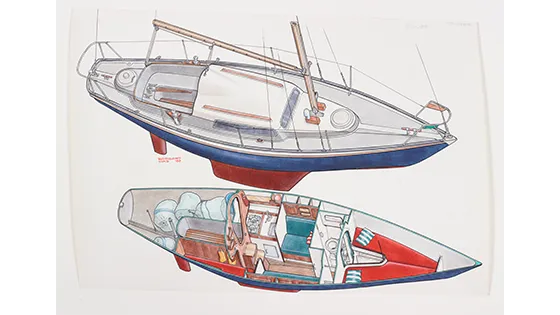In late May '23, The National Maritime Museum will open the new exhibition 'Water sports in Perspective,' which is entirely dedicated to the drawings of illustrator and futurist Robbert Das. This temporary exhibition features drawings that were acquired in 2019, and the ship drawings were created with an exceptional eye for detail.
From a young age, Robbert Das (1927), together with his twin brother Rudolf (1927-2020), made numerous perspective drawings of, among other things, ships, and aviation. Starting in 1966, the Das brothers published a series of books outlining their vision for urban planning and transportation. Some of their ideas and predictions later became reality, leading them to be recognized as futurists. Each brother had their own preferred subjects, with Rudolf choosing architecture and urban planning, while Robbert followed his passion for the maritime world.
Illustrator
His ship drawings are exceptionally accurate. Both the exterior and interior of the ships are intricately detailed. The cross-section of a yacht's hull shows not only the construction but also the interior. In the almost seventy years that he worked as an illustrator, Das depicted many iconic ships, from the schooner Atlantic (1903) to the Pionier (1958), and from the speedboat Miss England II (1930) to the record-breaking sailboat Hydroptère (2008). He used photos and design drawings of yachts as study material for his illustrations. He has never wanted to use computers.

Pionier in perspectief, 1993, Robbert Das
Collectie Het Scheepvaartmuseum
Futurist
Das enjoyed contemplating the future and drew ships with hydrofoils that lift the ship out of the water at high speeds. He also came up with a swing keel that provided more stability and allowed for a larger sail area on the ship. He did this twenty years before the swing keel became a reality. The multi-hull ships he drew are also ultra-modern and lightweight, with minimal water resistance, making them appear to skim over the water on paper. He drew ships with rigid sails that resembled airplane wings more than traditional sails. Sometimes he ventured into designing a yacht. The Rhino, an inexpensive aluminium ocean-going yacht, is known as an exceptional design due to its hull shape and large space below deck. As far as is known, it was never actually built.
The exhibition space is in the same wing as the navigation instruments on the east side of the building. This part of the National Maritime Museum is a delight for both water sports enthusiasts and technology enthusiasts and will fascinate everyone with its eye for detail on both aesthetic and design-technical levels.
This temporary exhibition can be seen until October 2023.